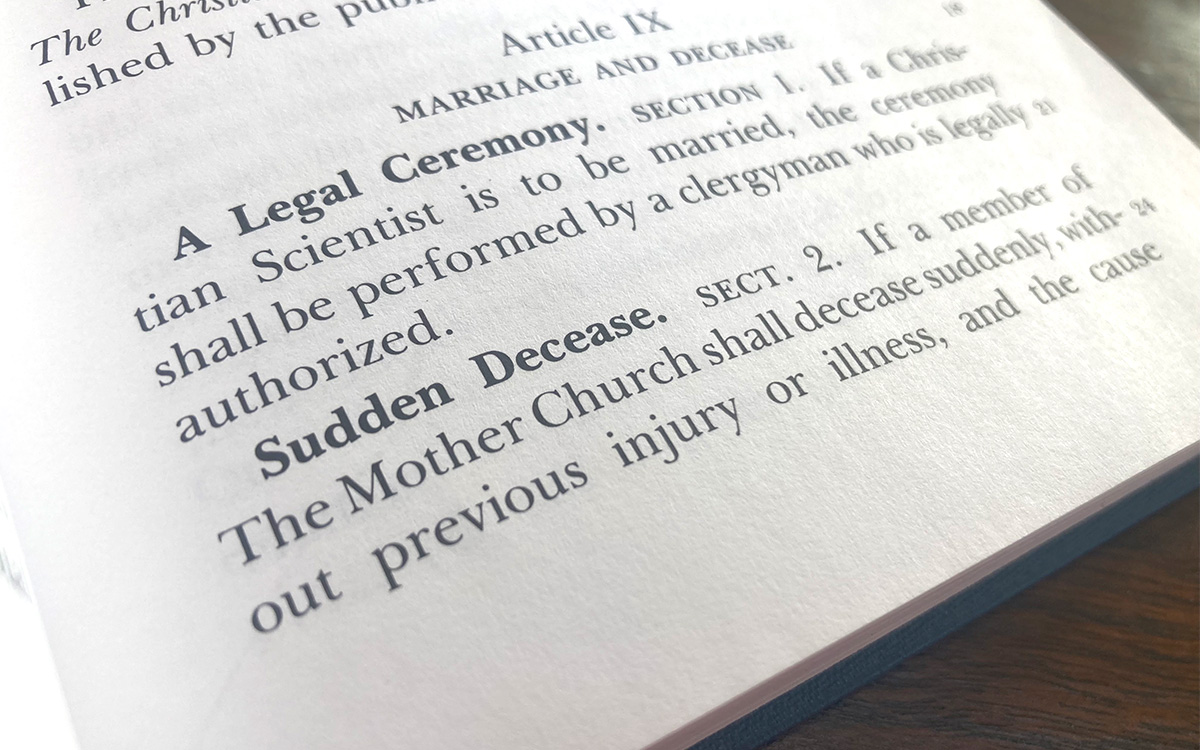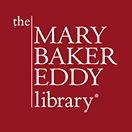What’s the background on the By-Law titled “Sudden Decease”?

Patrons of The Mary Baker Eddy Library sometimes ask about the history of Article IX, Section 2: “Sudden Decease,” found in the Manual of The Mother Church:
Sudden Decease. Sect. 2. If a member of The Mother Church shall decease suddenly, without previous injury or illness, and the cause thereof be unknown, an autopsy shall be made by qualified experts. When it is possible the body of a female shall be prepared for burial by one of her own sex.
Two events occurred in the weeks before Mary Baker Eddy wrote this By-Law in 1907, although it is unclear what role either played in its formation.
The first event related to the the death of her husband Asa Gilbert Eddy, in 1882. At that time Eddy insisted that an autopsy be performed on his body. After the autopsy concluded that heart disease was the cause of death, Eddy stated that the cause was “the mesmeric work of an enemy.”1
Twenty-five years later, Eddy faced a lawsuit that challenged her competency. The plaintiffs, known as the “Next Friends,” resurfaced the Gilbert Eddy autopsy, while making claims against Eddy’s ability to manage her affairs. It appears they thought her 1882 remark about the cause of her husband’s death would support their case. On August 17, 1907, the San Francisco Chronicle reported that the plaintiff’s attorney John Kelley wanted to read several letters in court, but that “counsel for Mrs. Eddy frequently objected, especially to one which was alleged to show that Mrs. Eddy had insisted on an autopsy upon the body of her husband….” And that “as this letter was written in 1882, it was ruled out as being too remote.” It is unclear why focus centered around this letter, but one of the subheadings for the Chronicle article is perhaps noteworthy: “AUTOPSY ON HER HUSBAND.”2
The second event involved the death of Charles Adolphus Murray, the 7th Earl of Dunmore, on August 27, 1907. Later that day, Lady Gertrude Murray, the Countess of Dunmore, sent a telegram to Calvin Frye, a secretary to Eddy, notifying him of the Earl’s passing.3 The following day The New York Times published an article that called Dunmore the “most prominent Christian Scientist in England” and stated that he had died suddenly.4 That day in England, a Manchester Evening News article reported that the Deputy Coroner for West Surrey, Dr. Gilbert H. White, had ordered a “post-mortem examination” (an autopsy) on Dunmore. Dr. F. N. Brown performed the post-mortem.5
A week later, on September 4, 1907, Eddy sent the Christian Science Board of Directors the first sentence of the By-Law titled “Sudden Decease.”6 It was published on the editorial page of the September 14, 1907, Christian Science Sentinel. The timing and placement of this announcement are suggestive. The first article on that editorial page was “A Benediction” from Mary Baker Eddy to the Dunmore family. It was followed by “A New By-Law”—“Sudden Decease,” followed by “Lord Dunmore,” an obituary reprinted from The Times of London.7
On September 19, several newspapers published articles about the new By-Law. “Christian Scientists Make Strange Rule” ran in the Union-Advertiser (Rochester, New York), quoting William B. Johnson, a member of the Board of Directors:
[Johnson] said to-day that this article was inserted in the by-laws at the last meeting of the directors, merely to emphasize the fact that the church was not hostile to the laws governing “coroner’s investigations” and to call the attention of the public to this fact. He wanted to have it understood that the new law did not mean the [a]bandonment of any previous teaching and proved no surprise to Christian Scientists. Asked if the rule was inspired by Mrs. Eddy, Mr. Johnson said that this was undoubtedly so, that this was the case with all changes in the church regulations.
A September 20 article from The Boston Globe reported that a Globe reporter had spoken with and quoted Alfred Farlow, Committee on the Publication for The Mother Church:
I had nothing to do with the framing or adoption of the bylaw, therefore I can only give an opinion of its purpose. It seems to be instituted more as a protection to Christian Scientists than for any other purpose, and at the same time it favors the authorities whose duty it is to clear up the mystery of sudden deaths.8
The first sentence of “Sudden Decease” was printed in the 66th edition of the Manual (1907).
Almost a year later, in a letter of August 18, 1908, Eddy asked Archibald McLellan, the chairman of the Board of Directors, to purchase a lot in Mount Auburn Cemetery, Cambridge, Massachusetts, for “no one in particular.” She added that “there is no death; Life is everlasting” and asked McLellan to “keep this as private as possible.” On the next page, she added this:
I do not believe in the propriety of a man dressing the corpse of a woman and vice versa. But I do urge the propriety of one sex doing this for the same sex. I wish to impress this as my proper sense of obsequies upon the minds of all Christian Scientists.”9
Some months later, on May 22, 1909, Eddy submitted an updated version of “Sudden Decease” to the Directors, which included the second sentence, as it appears in the Manual today: “When it is possible the body of a female shall be prepared for burial by one of her sex.”10 We were unable to determine if any specific event prompted that 1909 update. The final version of the By-Law first appeared in the Manual’s 81st edition (1909).
- See Robert Peel, The Years of Trial (Boston: The Christian Science Publishing Society, 2003), 115–116; Gillian Gill, Mary Baker Eddy (Reading, Massachusetts: Perseus Press, 1998), 288–291.
- “Read Letters of Mrs. Eddy,” San Francisco Chronicle, August 17, 1907.
- Lady Gertrude Murray to Calvin A. Frye, 27 August 1907, IC029.11.038.
- “Earl of Dunmore Dead,” The New York Times, August 28, 1907.
- “Late Earl Dunmore,” Manchester Evening News, August 28, 1907.
- Eddy to the Christian Science Board of Directors, 4 September 1907, L00953.
- “Lord Dunmore,” The Times, August 28, 1907.
- “New Bylaw is a Protection,” The Boston Globe, September 21, 1907.
- Eddy to Board of Directors, 18 August 1908, L06475.
- Eddy to Board of Directors, 22 May 1909, L01016.

